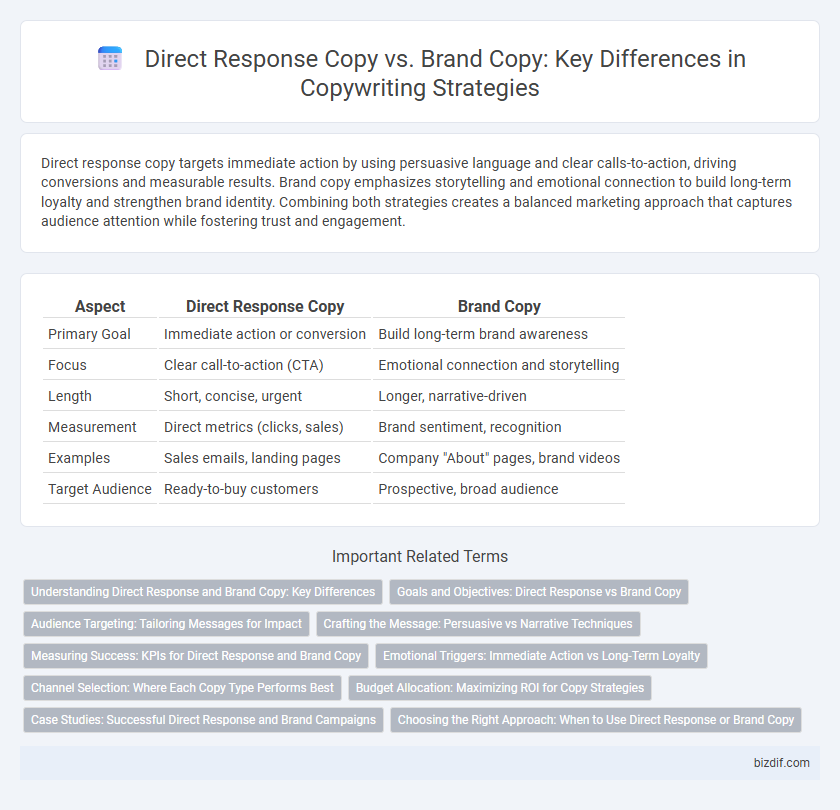Direct response copy targets immediate action by using persuasive language and clear calls-to-action, driving conversions and measurable results. Brand copy emphasizes storytelling and emotional connection to build long-term loyalty and strengthen brand identity. Combining both strategies creates a balanced marketing approach that captures audience attention while fostering trust and engagement.
Table of Comparison
| Aspect | Direct Response Copy | Brand Copy |
|---|---|---|
| Primary Goal | Immediate action or conversion | Build long-term brand awareness |
| Focus | Clear call-to-action (CTA) | Emotional connection and storytelling |
| Length | Short, concise, urgent | Longer, narrative-driven |
| Measurement | Direct metrics (clicks, sales) | Brand sentiment, recognition |
| Examples | Sales emails, landing pages | Company "About" pages, brand videos |
| Target Audience | Ready-to-buy customers | Prospective, broad audience |
Understanding Direct Response and Brand Copy: Key Differences
Direct response copy aims to provoke immediate action by using clear calls to action and persuasive language tailored to drive conversions, making metrics like click-through rates and sales the primary focus. Brand copy builds long-term customer relationships through storytelling and emotional engagement, enhancing brand identity and loyalty without emphasizing immediate responses. Understanding these key differences ensures selecting the appropriate strategy to meet specific marketing objectives effectively.
Goals and Objectives: Direct Response vs Brand Copy
Direct response copy aims to generate immediate actions such as clicks, sales, or sign-ups by using persuasive calls to action and clear value propositions. Brand copy focuses on building long-term relationships, enhancing brand awareness, and establishing emotional connections through storytelling and consistent messaging. Both approaches require distinct goals: direct response prioritizes measurable conversions, while brand copy emphasizes reputation and loyalty over time.
Audience Targeting: Tailoring Messages for Impact
Direct response copy targets specific audience segments with clear calls to action, leveraging data-driven insights to maximize immediate conversions. Brand copy focuses on building long-term relationships by crafting messages that resonate emotionally and align with the audience's values and identity. Effective audience targeting in both approaches requires analyzing demographics, psychographics, and behavior patterns to tailor messages that drive engagement and loyalty.
Crafting the Message: Persuasive vs Narrative Techniques
Direct response copy relies on persuasive techniques such as clear calls-to-action, urgency, and benefit-driven language to prompt immediate consumer action. Brand copy emphasizes narrative techniques, weaving compelling stories and emotional connections to build long-term loyalty and brand identity. Effective copywriting balances these approaches by tailoring the message to either drive conversions instantly or cultivate ongoing audience engagement.
Measuring Success: KPIs for Direct Response and Brand Copy
Measuring success in direct response copywriting hinges on KPIs like conversion rate, click-through rate, and return on ad spend, which directly track audience actions and immediate revenue impact. Brand copy success is assessed through metrics such as brand awareness, customer sentiment, and engagement rate, reflecting long-term relationship building and brand equity growth. Accurate evaluation requires aligning KPIs with campaign objectives to optimize either immediate response or sustained brand loyalty.
Emotional Triggers: Immediate Action vs Long-Term Loyalty
Direct Response copy leverages emotional triggers such as urgency, fear, and desire to prompt immediate action, often using clear calls-to-action and time-sensitive offers. Brand Copy focuses on building emotional connections through values, storytelling, and trust, aiming to cultivate long-term customer loyalty and brand affinity. Understanding these emotional drivers enables marketers to tailor messages that either drive quick conversions or foster enduring relationships.
Channel Selection: Where Each Copy Type Performs Best
Direct response copy thrives on channels with immediate engagement potential like email marketing, pay-per-click ads, and social media platforms optimized for calls-to-action, driving measurable results and conversions. Brand copy excels in channels that build long-term relationships such as corporate websites, content marketing blogs, and storytelling-driven video campaigns that enhance brand perception and loyalty. Selecting the right channel depends on campaign goals, with direct response targeting quick actions and brand copy focusing on sustained audience connection.
Budget Allocation: Maximizing ROI for Copy Strategies
Direct response copy requires a higher budget allocation for immediate conversion tracking and analytics to maximize ROI through measurable actions such as clicks and purchases. Brand copy focuses budget on long-term engagement and emotional connection, emphasizing consistency and trust-building that gradually influence customer loyalty and lifetime value. Allocating funds based on campaign goals and performance data ensures optimized returns by balancing short-term sales with sustained brand equity growth.
Case Studies: Successful Direct Response and Brand Campaigns
Case studies reveal that successful direct response campaigns, such as Airbnb's targeted email blasts, achieve measurable increases in conversion rates and immediate sales impact. In contrast, brand copy examples like Nike's "Just Do It" exemplify long-term brand equity growth and emotional connection with audiences through storytelling. Analyzing metrics from these campaigns highlights how direct response focuses on immediate action while brand copybuilding sustains loyalty and recognition over time.
Choosing the Right Approach: When to Use Direct Response or Brand Copy
Choosing the right copywriting approach depends on campaign goals and audience engagement. Direct response copy drives immediate action through clear calls-to-action and measurable results, ideal for sales or lead generation. Brand copy focuses on building long-term customer relationships and trust by conveying core values and emotional connections, best suited for awareness and loyalty campaigns.
Direct Response vs Brand Copy Infographic

 bizdif.com
bizdif.com